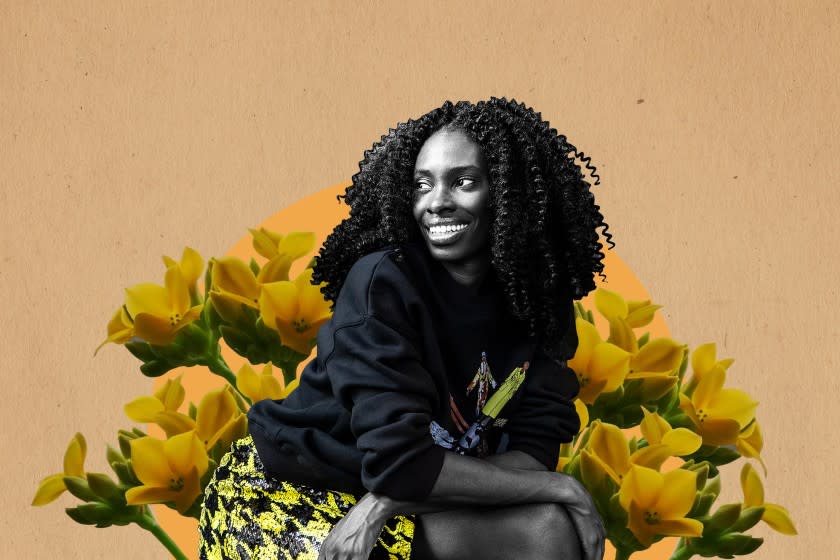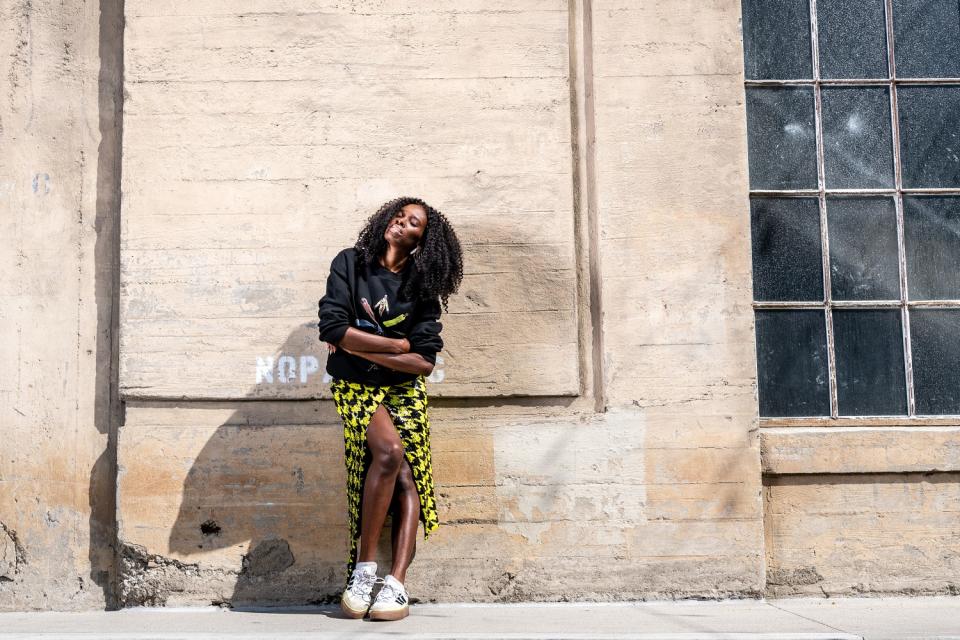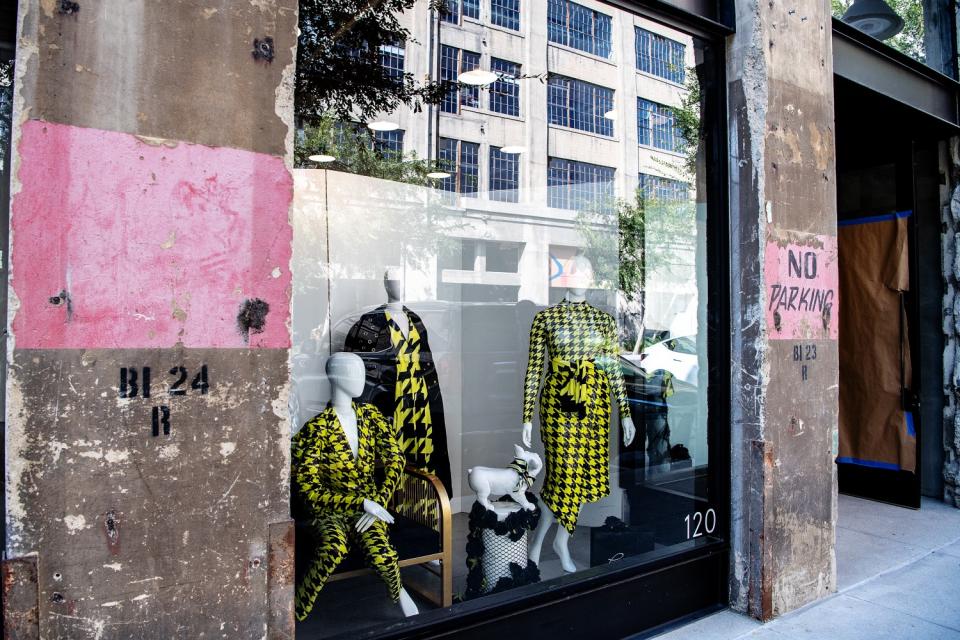Inclusive designs helped her win 'Making the Cut.' Now she's setting up shop in L.A.

- Oops!Something went wrong.Please try again later.
As I wrapped up an interview with Andrea Pitter, the second-season winner of Amazon’s runway-to-retail reality TV show “Making the Cut,” outside her soon-to-open boutique at Row DTLA, a big, blue Amazon delivery truck rumbled up and pulled to a stop.
As if on cue, Pitter popped up from her bench with all the energy of an uncoiling jack-in-the-box, went to the side of the van and leaned over, flashing a wide smile and a V-for-victory sign next to the swooping Amazon arrow logo.
She was wearing a chartreuse sequin houndstooth-check wrap skirt, a black, screen-printed sweatshirt with the sleeves pushed up past the elbow and a pair of Adidas X Ivy Park platform sneakers. It was a serendipitous made-for-social-media moment that briefly set my Instagram feed on fire.
A few minutes later, the New York-based designer was inside the store perched on a chair amid a jumble of boxes and partly dressed mannequins, broadcasting a live Instagram video to some of her 34,500 followers logging on from as far away as the Netherlands and Brazil and answering questions about everything from what big thing she’s up to next (“I’m considering moving to L.A.,” she answers matter-of-factly) to which celebrity she’d love to see wearing her new ready-to-wear collection (“Beyoncé. My answer is never not going to be Beyoncé”).
The 32-year-old bridalwear designer is on social media a lot; beaming live videos out into the universe and interacting with fans about twice a day since the Aug. 6 reveal of her big win. (She was actually crowned the winner in October of last year after the finale of the quarantined-for-two-months-in-Malibu season was shot.)
That was when she found out that in addition to the $1 million top prize and a year-long mentorship with Amazon Fashion she had won a three-year, no-cost lease on a 600-plus-square-foot shop in the downtown Los Angeles retail complex.
Fast-forward 11 months from the win, and she was boots (well, sneakers) on the ground last month, unpacking boxes, dressing mannequins and making sure the name Pantora is set in the subway-tile walls to her satisfaction. (“Making the Cut” fans will recognize the subway-stop theme from the concept-store challenge in the penultimate episode of the season.)
After her ready-to-wear store opens, Pitter plans to turn her focus to the unfinished space next door — an approximately 1,000-square-foot storefront that will be home to a West Coast outpost of her Brooklyn, N.Y.-based Pantora Bridal boutique. Although the second store isn’t technically part of the “Making the Cut” prize purse, she says that being able to double-down on L.A. bricks-and-mortar — as well as having the flexibility to push her stores’ opening dates as she sees fit — are benefits of her big win.
Time still is money, but it balances out a little bit. The exchange rate is different.
Andrea Pitter, winner of 'Making the Cut' season 2
“I don't know if I would have done both,” Pitter says about opening two stores in downtown Los Angeles. “I think when I sat down and started to realize that I had the resources to do both, it made sense. Like, you know, free lease! … I think that's one of the most beautiful things about this experience: I'm giving myself the gift of time. Before, I didn't feel like I had enough time because I didn't have enough resources. Now I can go, ‘Hold on, take time and think about this.’ … Before, if I’d signed a lease on Oct. 1, I would have had to open the store on Oct. 2 before I’d even had time to think about what I wanted to do because time was money. Time still is money, but it balances out a little bit. The exchange rate is different.”
Professionally, she says, winning the Heidi Klum- and Tim Gunn-hosted reality show looking for the next great global fashion brand was like flipping a light switch. “I [already] thought I was great," she says. "I thought I was an amazing designer. I’d started my brand when I was 16 — so that’s half my life — and I’ve had the [bridal] store for eight years. And all of a sudden I’m in a staff meeting, and managers are like, ‘We have orders from the Netherlands.’”
Later, Pitter corrected herself, noting that her brand — and her fashion-design career — actually started four years earlier, when the 12-year-old daughter of Jamaican immigrants applied to the High School of Fashion Industries in New York City.
“They needed a portfolio for entry, and I said, ‘OK, I'm going to create a portfolio [and] I'm going to create a brand," she says. "And the brand name is going to be Pantora: P for Pitter, ‘an’ for Andrea and Tora is my middle name.’”

From there, she attended the Fashion Institute of Technology (graduating with a bachelor of fine arts degree with a specialization in fashion) after which she embarked on a series of design jobs that eventually led to a focus on bridal.
“I was getting commissioned to do bridal gowns online,” she says. “At one point, when I had maybe my third job out of college — all of my jobs were very short-lived — I was working as a corporate designer at Fetch for Pets, designed all the pet wear, and I was like, ‘Andrea, focus!’ I was using my lunch breaks to buy fabric to do the work for my personal business. … I would work an eight-hour shift at my corporate job and then come home and probably put in about eight to 12 hours and then getting four hours of sleep. It was not sustainable.
“So I quit my job," she says. "That’s when I said, ‘You have to pick something — one thing — focus on that, get good at it. And once you're good, you can do anything else that you want to do but you have to focus.’ That’s when I realized bridal was the thing.”
Pitter calls her approach to bridalwear “relatable luxury.” “I want brides to feel like they're an elevated version of themselves rather than creating this storyline about who they're supposed to be on their wedding day,” she says. ”[Pantora is] a safe place where they can experience bridal without putting their pinky up.”
For Pitter, making those brides feel like elevated versions of themselves also means reflecting who they actually are — size- and shape-wise. “Our size chart is hip-conscious because we wanted to honor curves,” she says. “Black women come in so many different shapes and sizes, and our curves are so often forgotten.” The same thing goes, she says, when it comes to use of illusion mesh — the sheer fabric used in the dress panels and linings to create an illusion of bare skin underneath.
“When there was this whole big illusion-mesh trend, it didn’t really exist for Black women,” Pitter says. “And Black women were almost being forced to buy what was being presented to them, which was a peach color. … The thing is, the majority of my brides were Black. So it was just like, ‘I'm not going to offer you peach.’ It didn’t make any sense, and I realized it was lacking.”
Her solution was to create Forgotten Skin Tones, a full line of mesh and linings catering specifically to women of color. (It’s worth pointing out that Pitter isn’t the first — or only — dress designer to practice this kind of color-matching wardrobe wizardry.)
“The [inclusive] sizing and the Forgotten Skin Tones established me as ‘the girl who understands us, who gives us the thing that we need,'” Pitter says.
That emphasis on inclusive designs was one of the factors that helped put Pitter in the "Making the Cut" winner's circle despite winning only a single challenge across the season's arc. In the final episode (in which supermodel judge Winnie Harlow cast a tie-breaker vote), then-Amazon Fashion President Christine Beauchamp said Pitter's formal business pitch, which was part of the challenge along with creating a 10-look finale collection, and its focus on creating clothes for women of every body shape and skin tone were a powerful part of the designer's presentation.
Given Pitter's activity level on social media, I couldn't help but ask if it had anything to do with a different tie-breaker — the one in the season's second episode when, despite having a stronger collection, she lost when a group of influencers judged another designer’s posed-model photos better in a social-media-themed challenge.
“I've never not been on social. I just didn't do well on that assignment,” she says, adding that she has found herself doing more Instagram Live streams since “Making the Cut.” “I would probably go live maybe a couple times a month pre-show. You’ve been catching me doing two a day when I have downtime and nothing else going on. But I try to get on for 10 or 15 minutes because I'm also kind of learning my customer too.”
What has she learned so far? For starters, that interaction on social media can turn followers into customers.
“I think that we have more of a conscious buyer now,” she says. “People are connecting to the owners of the businesses. I think people go, ‘Oh, she's really relatable! Oh, we like her. Oh, she said she wears sequins in the daytime. Let me try that out.’ I’ve noticed that, when I go live, there's a spike in sales. And if I post a picture of myself in a particular outfit, that [accounts for] the highest sales for the day.”
Interacting with followers, fans and customers online has also made Pitter realize she wasn’t being quite as inclusive as she thought she was.
“It's so fascinating. When I thought about who my customer was, I knew I wanted to be inclusive — that's inclusive in body type and inclusive in race — but I never really thought about how inclusive I was when it comes to age. Am I making sure that everybody feels like they can wear these clothes? Or did I isolate it to a group under a certain age?” For that introspection, she cited a group she calls her “internet aunties.”
“They’re all 50 and over and fabulous and they hashtag things like #styling50andover," she says. "And they’re sharing their unboxing pictures with me. ... So now I kind of have an idea of who this new customer is and how I’m transcending so many areas of age, race and body type. And I'm really thrilled about being able to design in a circular way. It's joyful.”
Briskly selling livestream looks aside, Pitter says she couldn’t easily quantify the halo effect her reality-TV turn has had on business (last year, Season 1 winner Jonny Cota told The Times his sales had jumped 500%) for two reasons. First, because the show marked her first foray into ready-to-wear after a decade in the bridal business, she says there's no sales comparison to be made. Second, she says that her bridal business had already been running at almost full tilt before her “Making the Cut” win.
“There were more appointments for sure, more bookings," she says. “But I can’t say anything like, ‘We’re doing double the business.’ The best way I can explain it is that we have four fitting rooms that run all day, and we were taking a certain amount of appointments per day. And we were almost at that cap. Now we're at that cap. The great thing is we actually will be doing double the [wedding] business because we're opening the bridal store at the Row DTLA."
Local brides-to-be will have to wait a little longer — at least until December. However, if everything goes according to plan, the wait will be only a matter of days — just until Oct. 17 — for anyone interested in popping by the postage-stamp-size store to see pieces from her finale collection up close.
The range of bodysuits, sequin-festooned blazers, asymmetrical sweater dresses, utility-chic jumpsuits and wide-legged pants is packed with symbolic references, including a heavy dose of chartreuse-and-black houndstooth checks (a callback, she says, to the last ready-to-wear capsule collection she designed before going all in on bridalwear a decade ago) and a swirly camouflage. ("That's from a point in the show when I wasn't winning," Pitter says, 'And I was like, 'It's not about the battle, it’s about the war.' So I hand-drew that camo design.")
What's next for Pitter? "I keep telling myself I have no ceilings, so I want to do all those things," she says. "I want collaborations. I want ad campaigns. I want everything. The first next thing is to open more bridal stores. And I'm trying to figure out how to incorporate the ready-to-wear into my current flagship store [in Brooklyn].

"And I've been talking about launching this personal campaign of 'Get up and put on your good clothes,'" she says. "We don't have to be in yoga pants all day, and I feel like if the options are available, that the clientele will come. There are people who want to spread joy and feel joy when they get up and they get dressed. And I feel like they'll find me. They'll find me with my chartreuse[-filled] windows!"
Pantora — and its chartreuse-filled storefront — can be found at Row DTLA, 777 S. Alameda Street, Los Angeles. Hours 11 a.m. to 6 p.m. daily. pantorabridal.com
This story originally appeared in Los Angeles Times.

